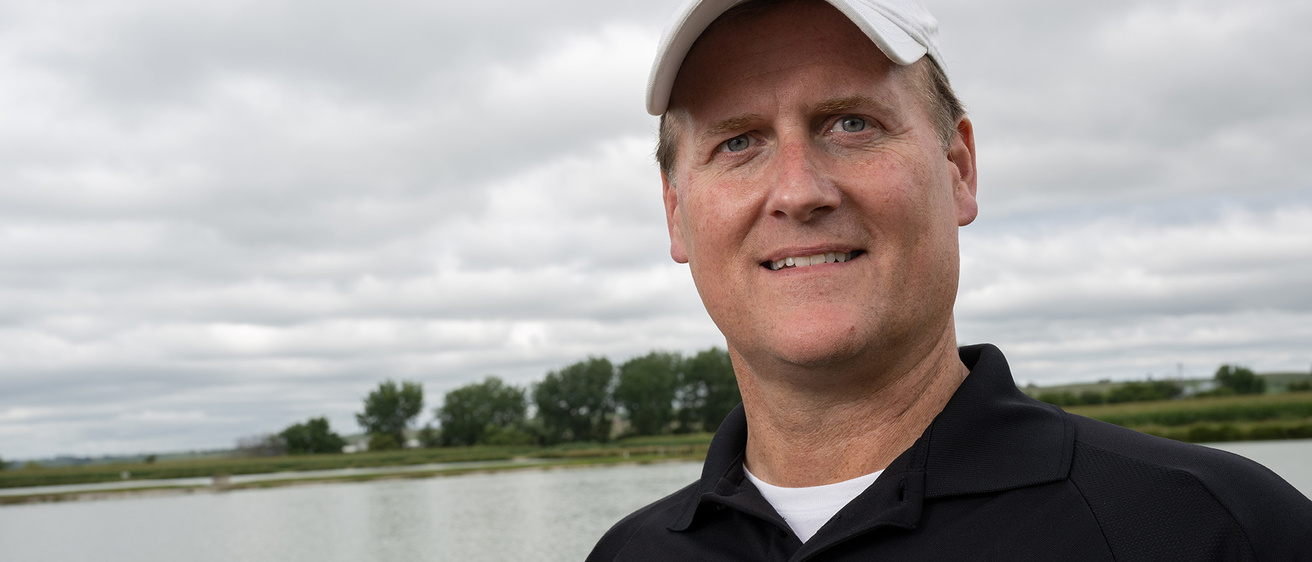Craig Just at the University of Iowa has sought an affordable wastewater solution for small towns. Now, through Just’s research, partnerships, and persistence, a pilot system in Dow City appears poised to meet federal wastewater treatment regulations. The technology would then be available for hundreds of small towns in Iowa.
Story: Richard C. Lewis
Photography: Tim Schoon
Videography: David Scrivner
Published: Dec. 30, 2024
In 2010, Craig Just walked into the town hall in Goodell, Iowa, and got an earful.
More than 60 residents — nearly half the Hancock County town’s population — had come out to tell Just, a civil and environmental engineer at the University of Iowa, about a $2.2 million bill the town faced to meet federal regulations to upgrade its wastewater treatment system.
“The passion they displayed kind of made the issue sink in even deeper for me,” recalls Just, who had been invited to visit after Goodell’s mayor read a story about his wastewater research. “I vowed at that time to find a way to make a difference.”
The University of Iowa civil and environmental engineer is on the precipice of making good on his personal promise. After nearly 25 years of research, funding, advocacy, and partnerships, a wastewater treatment system being tested in Dow City, Iowa, appears poised to meet federal guidelines and be permitted by the Iowa Department of Natural Resources.
That system would fulfill federal rules to treat wastewater fully. It also presents an option that would significantly lower upgrade costs for the hundreds of towns in Iowa that treat their wastewater using lagoons, or human-made retention ponds.
“For many towns, the only option would be to build more lagoons, which is a capital-cost loan they’re going to have to pay off for 30 to 40 years, and it doesn’t create any jobs, either,” says Just, Donald E. Bently Professor in Engineering in the College of Engineering. “The system we’ve been testing in Dow City has a much lower upfront capital cost and an affordable monthly cost, and it also can create jobs for small businesses in the area that want to help maintain these systems in partnership with these small towns.”
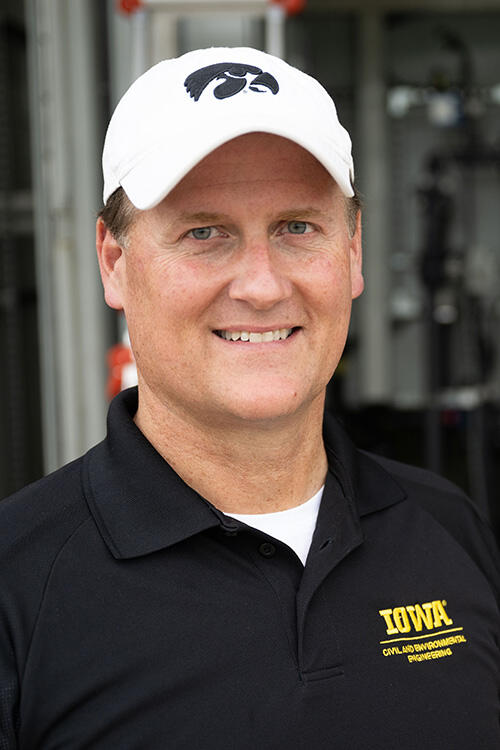
Craig Just
Just likes to joke that he’s been interested in wastewater since he first witnessed his toilet flush as a toddler. His involvement grew from his fascination with how humans leveraged the biology and chemistry of nature to treat a human byproduct, coupled with a desire to make sure that water treated and then released in Iowa’s rivers and streams is clean and healthy for aquatic life and recreational pursuits.
He has traveled far and wide, visiting towns large and small, logging some 10,000 miles a year crisscrossing the state to speak with Iowans, talk to engineers, and to view various wastewater treatment operations. Finding a rural solution appealed viscerally to Just, who grew up in Eagle Grove, a north-central Iowa town with about 3,600 residents.
“We have amazing, talented people in rural Iowa who are trying their best to keep their towns going, to do things that are right, in a way that doesn’t inflate their tax bills,” he says.
Just has been tinkering with wastewater treatment designs that would be the best financial match for small towns. His first foray was studying the viability of a submerged attached growth reactor — “essentially a box of rocks,” Just says — to remove pharmaceuticals in wastewater.
He has tried and tested other operations that would remove ammonia, a chemical compound that is a major component in human waste and is toxic to fish and other aquatic life.
In 2021, Just formed the Iowa Wastewater and Waste to Energy Research Program, with research at the university and a Tech Park located at Iowa City’s sprawling wastewater treatment campus south of town, to test commercially ready wastewater treatment technologies. That same year, he won $4 million from the Iowa Economic Development Authority to advance the research.
One system for which Just’s team collected data was a moving bed biofilm reactor, a rectangular structure outfitted with tanks configured to treat ammonia. The system had been designed by an Iowa-based company called BES Water Solutions. BES had installed similar models in a few small towns, including West Branch, Wayland, and Middletown, and Just was helping the company determine how these systems performed and how to optimize their operations.
“I realized the container, or at least what they put in the container, could not do everything that was needed,” Just says. “It didn’t have disinfection, for example. It also didn’t have a way to adjust the pH, which indicates how acidic or alkaline a substance is. It didn’t have a way to remove all the floating solids, at least not down to a level low enough to meet discharge requirements.”
The partners would need to keep looking for a solution.
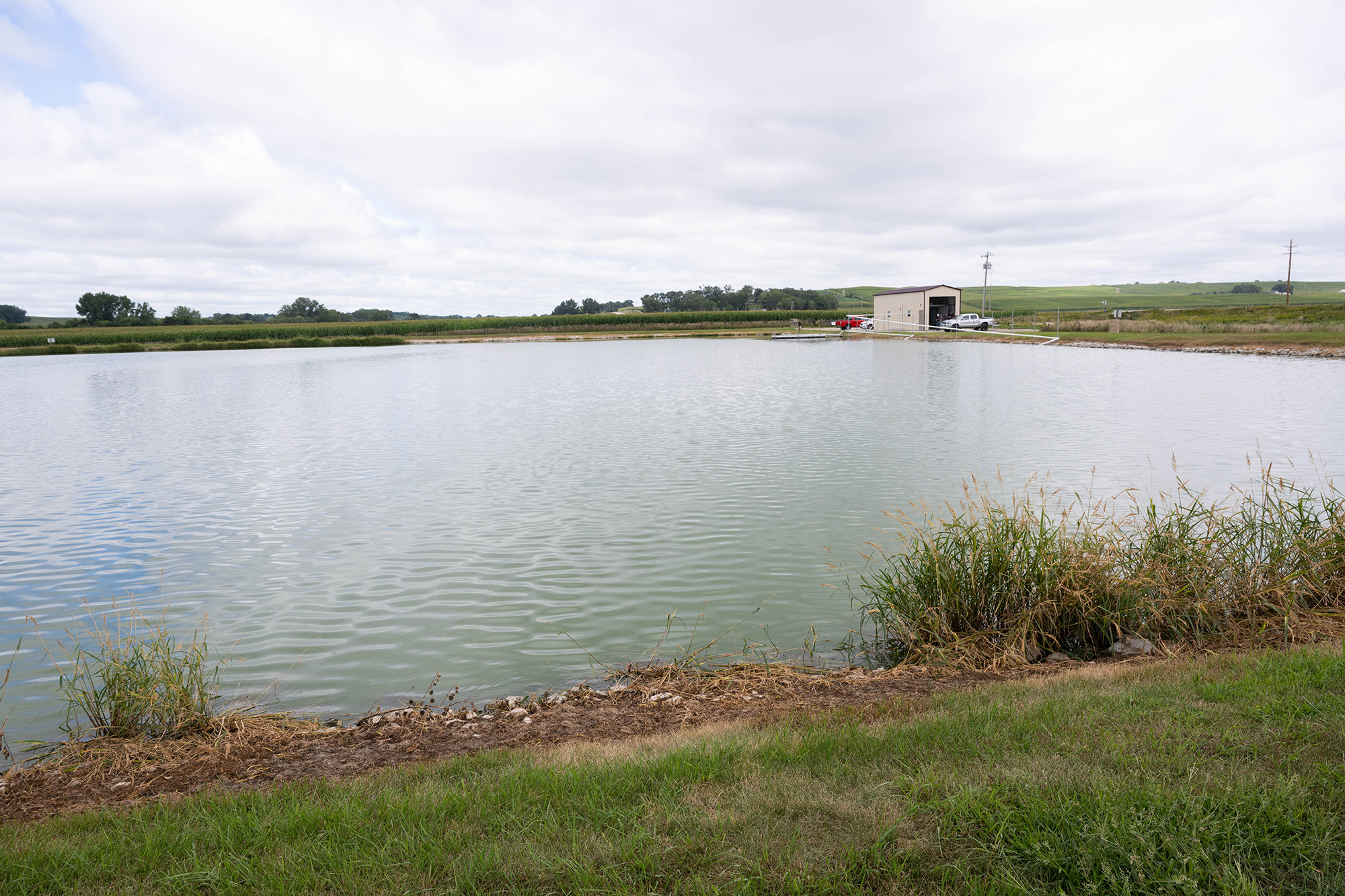
Lagoons like this one located on the northern outskirts of Dow City, Iowa, serve as the primary means to treat wastewater in hundreds of rural Iowa communities. Many of those lagoons were not designed to further reduce nutrients — such as nitrogen and phosphorous — currently required under federal rules. At the Dow City lagoon, UI researcher Craig Just is testing a wastewater treatment system that would fulfill federal rules to treat wastewater fully.
There are 722 communities in Iowa that use lagoons as the primary means to treat wastewater — the highest number of any state in the nation. Of that total, 531 towns have controlled-discharge lagoons, where wastewater is stored and released twice a year into a nearby stream or river. In these systems, bacteria in the water consume organics, while solid matter settles on the bottom as sludge — a simple, biological process that yields treated water for release.
While effective, the lagoons were not designed to further reduce nutrients — such as nitrogen and phosphorous — currently required under federal rules. These systems now must handle a full complement of wastewater issues, which Just calls “the Big Five”: suspended solids, oxidation, ammonia, bacteria, and pH.
“So, now these small towns are trying to figure out how to convert their lagoons from control discharge lagoons to continuous discharge lagoons,” says Nathan Seberg, director of business development at BES Water Solutions, who has been working closely with several Iowa communities on potential solutions. “That means they must convert a system where the water has been held for 180 days to a system where the wastewater is treated and released daily. There’s a big upgrade cost to that.”
Indeed, the cost to convert is substantial, with estimates ranging from $3 million to $7 million.
That’s what got the attention of Goodell’s mayor in 2010 and, more recently, other small-town leaders, such as Landon Burhoop.
Burhoop has lived in Dow City his entire life. He’s a former mayor, a former town councilor, and currently is the director of the public works department. His wife is a kindergarten teacher at the elementary school in town. He’s witnessed improvements to Main Street, growth with businesses downtown, and more houses built for families who have moved in.
“We’ve worked hard at making improvements to keep our town strong and to make it an attractive place to live,” he says.
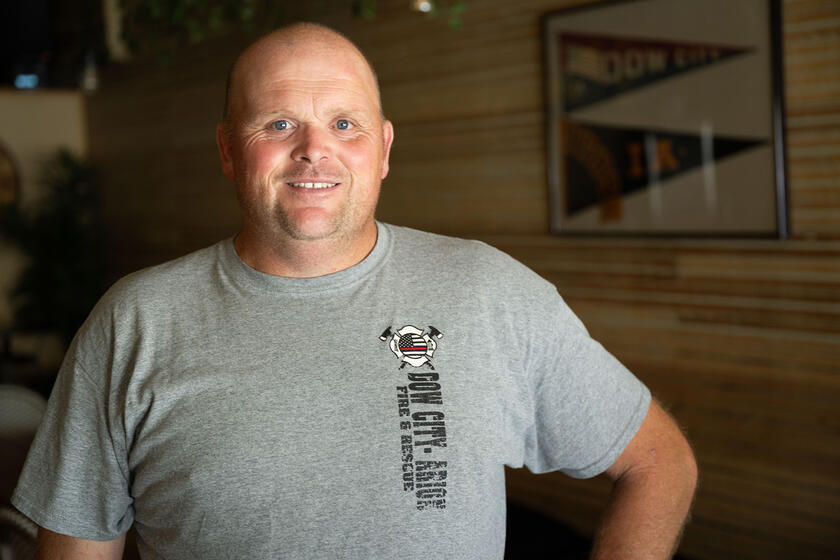
Landon Burhoop
Burhoop wants his community to meet the full wastewater-treatment standards. But he shudders at the cost.
“Our town would probably go down and disintegrate to nothing without a viable, affordable wastewater option,” he says. “You’ve got to have water and wastewater for your community to be able to maintain, if not try to expand.”
That sentiment is echoed by Connie Garrett, who has become intimately familiar with wastewater issues since being elected to Dow City’s town council in 2021. She, too, wants the wastewater to be fully treated, for the effluent to be as clean as possible, to be a good environmental steward — but at a price that won’t bankrupt the town.
“Building a new lagoon, it is just out of the question for a town of our size,” says Garrett, speaking behind the bar at O’Meara’s & Two Doors Down, the downtown restaurant she opened when she moved back to Dow City seven years ago. “It’s just too expensive. We have a lot of senior citizens. We’re in rural Iowa. I don’t know what the average income is here, but to keep raising rates to pay back a multimillion-dollar debt, it’s not affordable for the people in Dow City.”
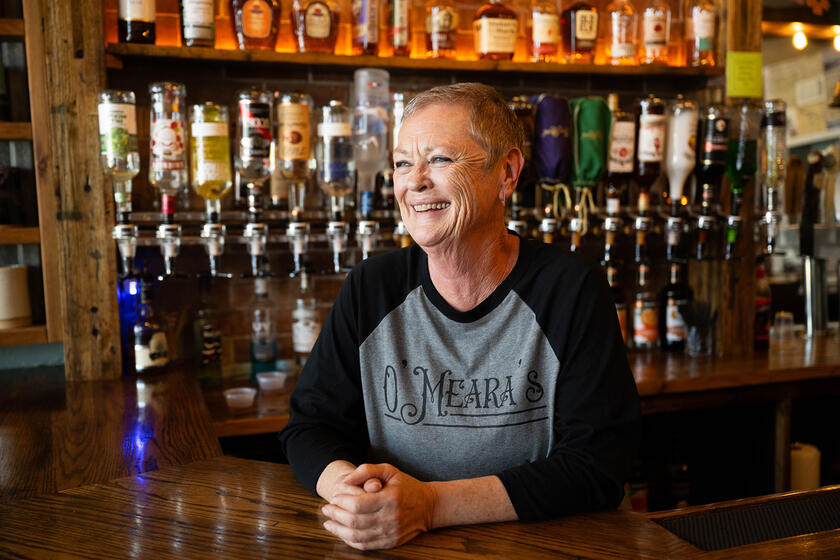
Connie Garrett
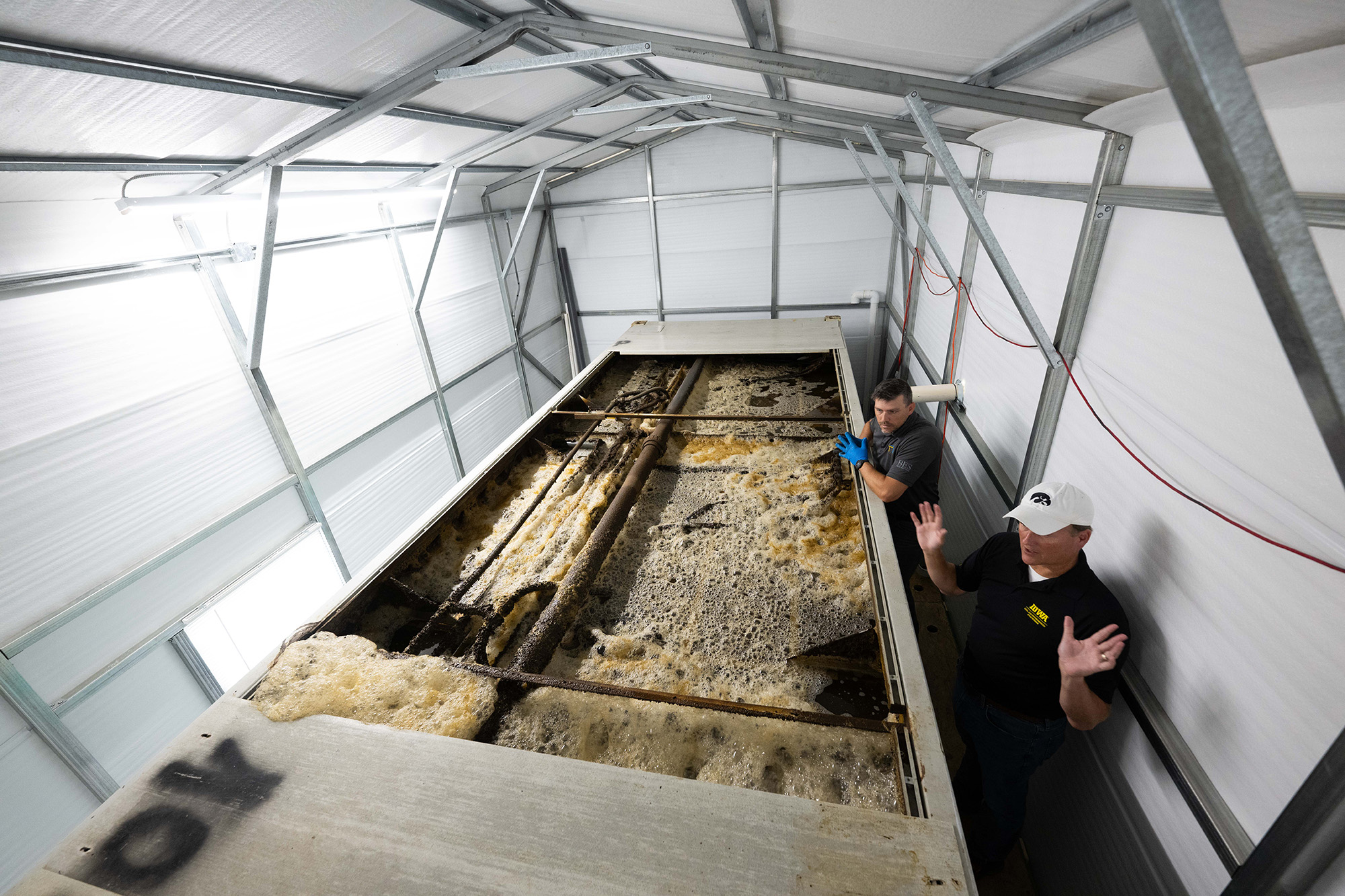
Craig Just, from the University of Iowa, and Nathan Seberg, with BES Water Solutions, partnered to test an advanced, compact wastewater treatment system in Dow City, Iowa. The system has met all cleaning, disinfection, and discharge requirements required under federal rules. Just expects the Iowa Department of Natural Resources to grant it a provisional permit — an expected first step toward a full permit — by early 2025.
Just first met BES’ principals in the parking lot of a Menards in summer 2020. It was just months into the COVID pandemic, and everyone was wearing masks. BES had promising wastewater designs in operation and sought the testing and data needed to obtain DNR permits.
“When we first started working together, Craig needed communities to go talk to, places to go see,” says Seberg, of BES. “I was able to bring him towns. I was able to bring him contacts. Craig was able to bring the expertise and guidance.”
But whether it was a moving bed biofilm reactor, a submerged attached growth reactor, or some other permutation, no single model fulfilled the Big Five objectives. Then, in October 2022, Just traveled to the Water Environment Federation Technical Exhibition and Conference (WEFTEC) in New Orleans. He attended talks on the latest research in wastewater, water quality, and other issues. During one break, he took a stroll in the capacious exhibit hall.
“I was going to a bunch of booths and just checking out what the latest was in wastewater treatment operations, in container configurations, or otherwise,” Just says. “I was looking for small-town solutions.”
At one booth, staged by a Minnesota-based company called Fluence, Just learned about a wastewater operation that achieved the Big Five. It had a small footprint, was simply designed, and could be moved and installed anywhere.
“I came back from WEFTEC and told BES, ‘I think you’d be a lot better off just buying one of these rather than making your own,’” Just recalls. “They agreed, especially if I purchased it.”
Just used $250,000 of his IEDA funding to buy the Fluence model, to be shipped and tested for the first time in Iowa — in Dow City.
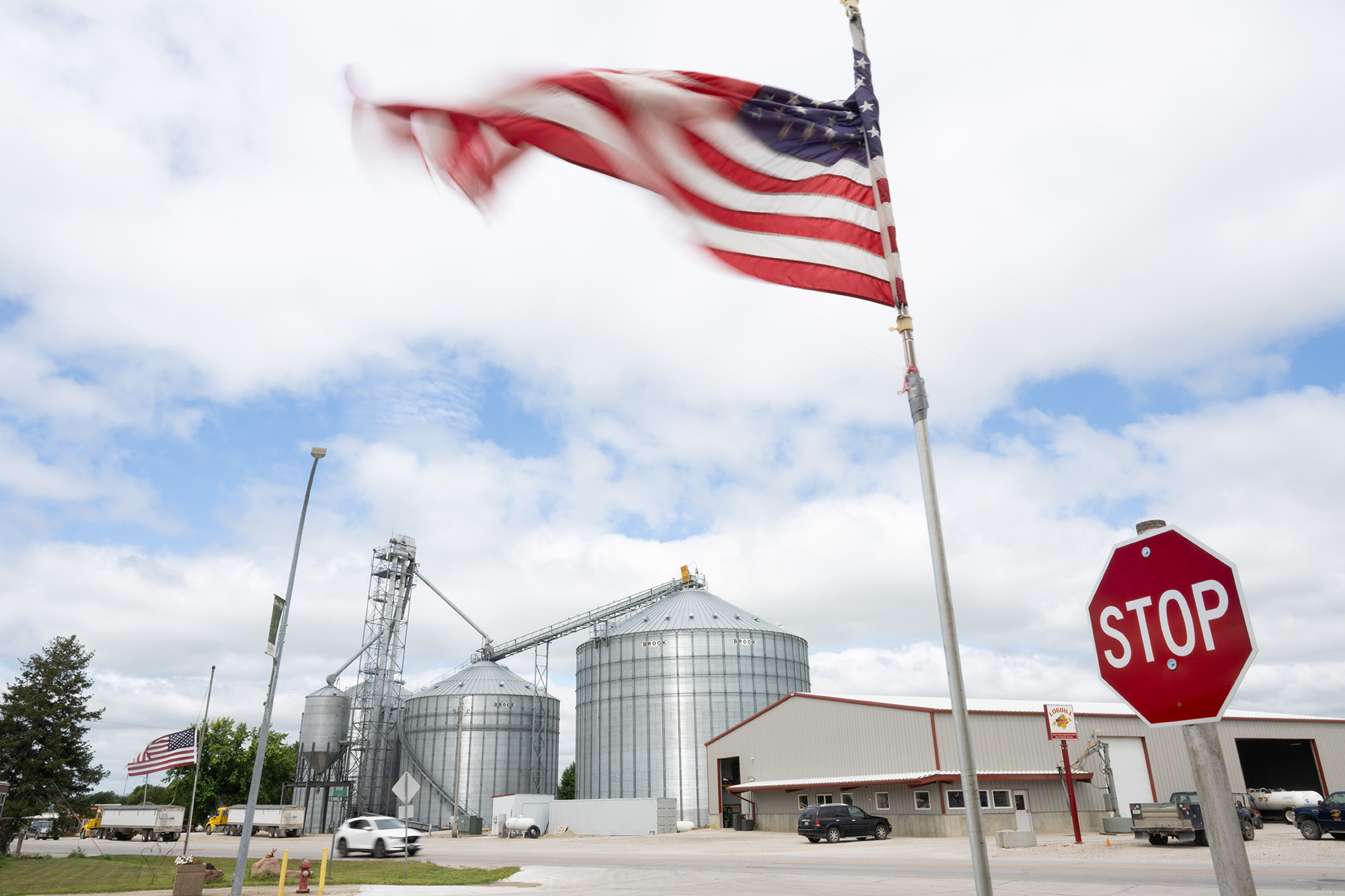
Dow City, Iowa, is one of 722 communities in Iowa that use lagoons as the primary means to treat wastewater. “Our town would probably go down and disintegrate to nothing without a viable, affordable wastewater option,” says Landon Burhoop, director of the Dow City public works department.
It’s a warm, sunny August day, and the water is still in the twin lagoons located just across Highway 30, on the northern outskirts of Dow City. Every now and then, the surface ripples and bubbles with the movement of frogs. The scene is serene, and if it were not for a faint whiff of sewage, one could mistake the lagoons for a couple of small lakes.
Just and Seberg stand next to Dow City’s wastewater treatment system, bought from Fluence and sited adjacent to one of the lagoons. It doesn’t look like a wastewater treatment operation but rather like someone plopped down a shipping container in the wrong spot. But inside the white, rectangular module, a ton of activity is taking place. In one compartment, bacteria colonized on coils are busily consuming organics in the brownish-green waters. In the next stage, a clarifier infused with air separates solids and returns the less-treated water to the bacteria chamber. The treated water is sent to an effluent tank, which can then either be released to the lagoon or further cleaned in the media filter.
The bottom line is that in a 20-foot by 50-foot footprint — about the length of a semitrailer truck — Dow City’s wastewater is getting the full treatment, with incoming sewage taken in and cleaned effluent discharged into the nearby Boyer River. The system, in tests since June, will meet all cleaning, disinfection, and discharge requirements. Just expects the DNR to grant it a provisional permit — an expected first step toward a full permit — by early 2025.
“It seems to be working at a cost that’s a lot cheaper for the town,” Burhoop says. “It’s really cool to see the treated product. It’s a whole lot different, and it’s a whole lot cleaner.”
“I didn’t have to do this, but yet it had to be done. And I felt that our program at the University of Iowa provided the space to make this happen. I was encouraged to do these types of things, and here we are.”
Garrett says nature has returned to the area.
“Having grown up here, I have never seen waterfowl on our lagoon,” she says. “That tells me it’s cleaner water, which is what we all want. We don’t want all that stuff going into our soil and into the river and polluting.”
Now, Just’s journey with wastewater — his quest to find the optimal solution for small-town Iowa, in the form of a miniaturized unit that is mobile, that can be expanded to meet a town’s future needs, and that satisfies all federal and state requirements — may be at hand.
“I mean, candidly, it is a bit emotional,” Just says, tears welling. “I didn’t have to do this, but yet it had to be done. And I felt that our program at the University of Iowa provided the space to make this happen. I was encouraged to do these types of things, and here we are.”
